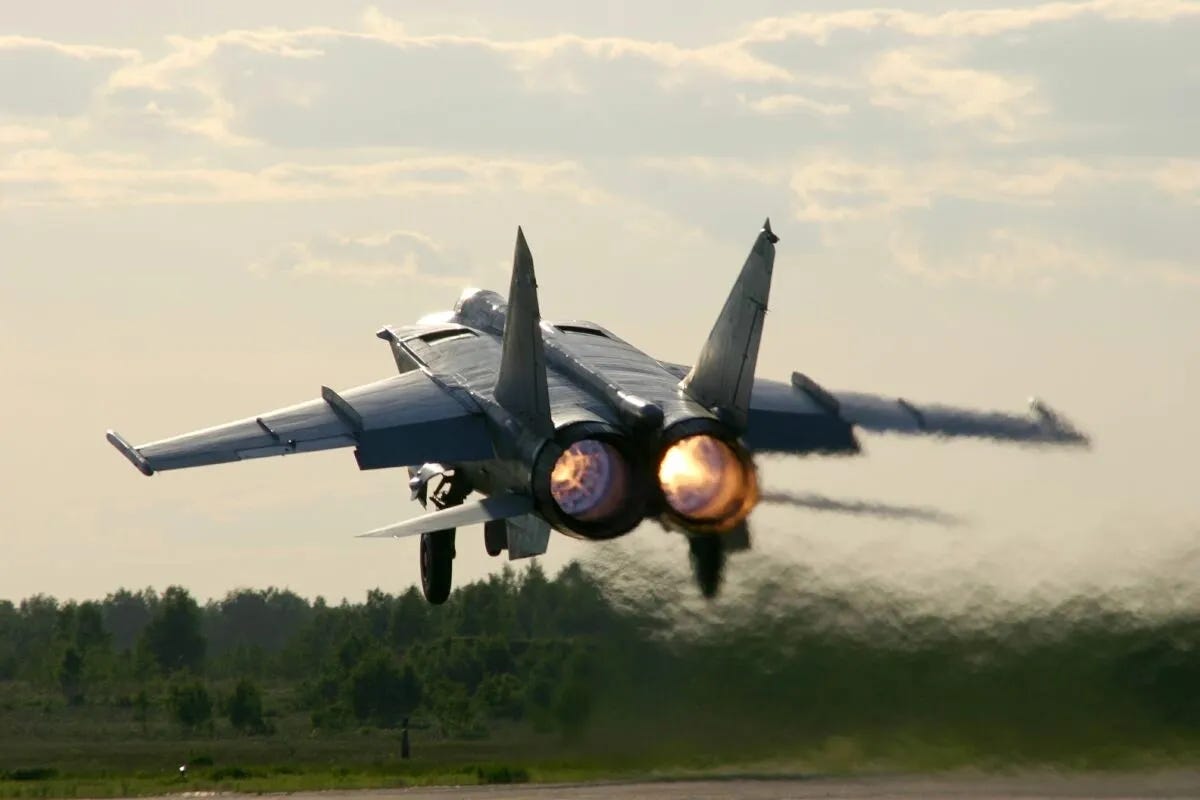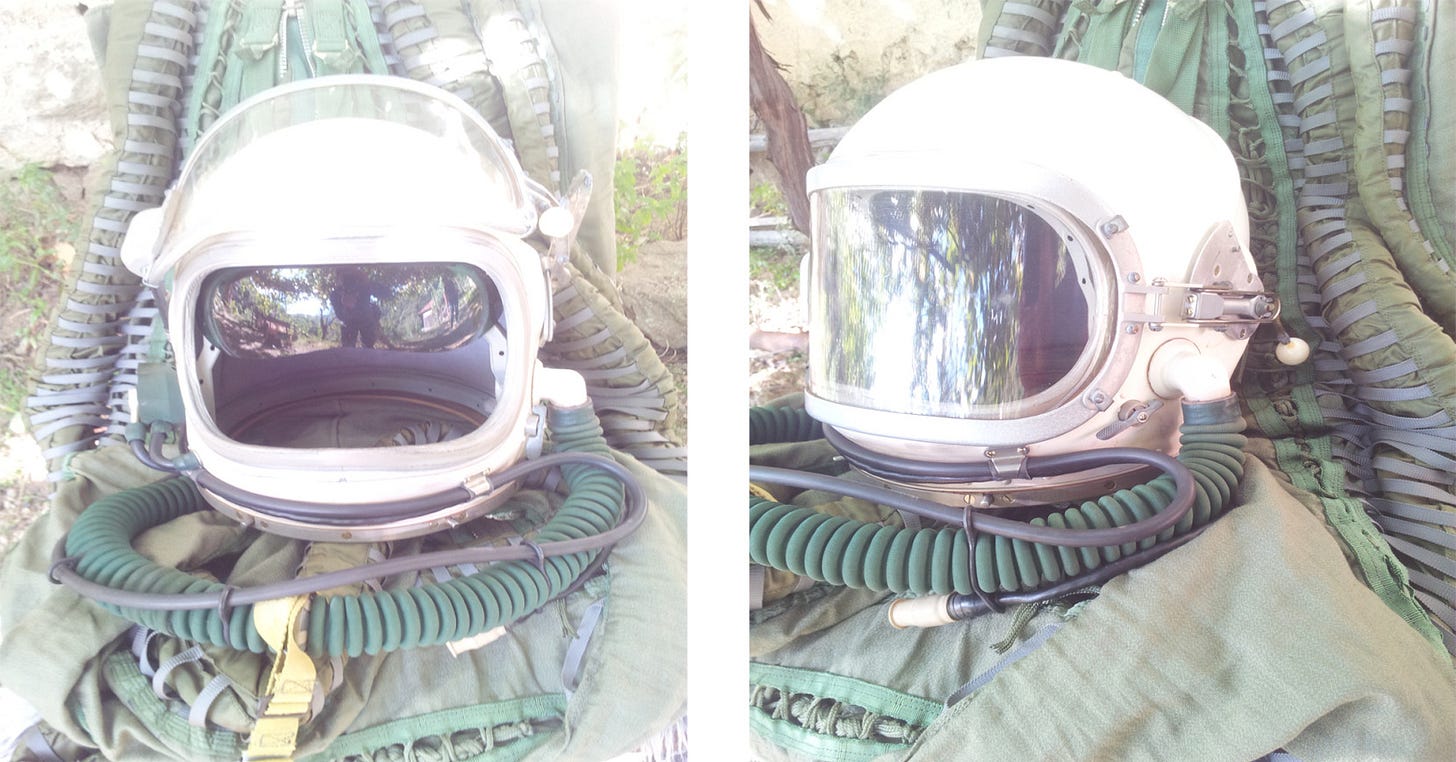Loneliness at Mach Three
Flying the Mikoyan MiG-25R Foxbat reconnaissance plane for the Indian air force
Indian air force air marshal Sumit Mukerji spoke with us about flying the world’s fastest operational aircraft.
What were your first impressions while flying the MiG-25R?
A 20-ton aircraft that carries 20 tons of fuel, flies in the stratosphere, cruises at Mach 2.5 in minimum afterburner and exceeds Mach 3.0 with ease when required—what can one say? It was an awesome airplane. The fact that the ventral fuel tank was one MiG-23 [equivalent in fuel] under the belly speaks for itself.
Which words best describe the MiG-25?
Catch me if you can.
What is the cockpit like and how pilot-friendly is it?
Most Russian aircraft cockpits evoke a feeling of comfort and familiarity to a pilot who has flown Russian aircraft before. Coming from the [Mikoyan] MiG-21 [Fishbed] to the MiG-25R was an easy transition. As one of our air chiefs remarked when the aircraft was demonstrated to him and he was stepping into the cockpit, “This is rather familiar. And, damn-it, it even smells the same!”
The cockpit was a little more spacious than the MiG-21; thankfully so, because we operated wearing a pressure suit (which, incidentally, was the same as that worn by Yuri Gagarin).
The two-seater—or trainer version—was unique; it is the only aircraft I know (other than the Tiger Moth, I guess) where the trainee sits in the rear seat. The design, to my mind, was an aeronautical engineering masterpiece. To put it rather simplistically, the camera block was removed from a single-seater and a cockpit created in that space.
The canopy, although the same as the other cockpit, appeared flush with the nose of the fuselage, as viewed from the rear cockpit. Thus, the trainee felt he was sitting in a single-seater when in the trainer.
The transition to going solo was a piece of cake. With the nose-wheel located behind the rear cockpit, a 90-degree turn onto a taxi track entailed the front cockpit extending over onto the grass beyond the track (at the “T”) before the turn was executed. A little unnerving, initially, for anyone (though airline pilots may not have felt uncomfortable).
What can you say about the performance of the MiG-25R?
It was a beast with immense power. It has been described by some as “an engine with a place for a pilot and some avionics.” The Tumansky R-15B engines each provided more than 10 tons of thrust to produce the desired performance.
In almost all the other aircraft I have flown, a regular climb is executed at constant TAS [true air speed: the speed of the aircraft relative to the air mass in which it is flying], with a progressive reduction of IAS [indicated air speed: the speed as shown on the airspeed indicator] as the altitude increases.
The Foxbat climbs at constant IAS with an increasing TAS, crossing abeam the take-off dumb-bell (if a reciprocal turn were to be executed after take-off) at 30,000 feet and increasing! She would be crossing 20 km [65,000 feet] in 6.5 minutes from wheels-roll, at a rate-of-climb of 100 meters per second [almost 20,000 feet per minute]—like a bat out of Hell if you didn’t come back from the max afterburner regime.
In comparison, the ROC of a MiG-21 was 110 meters per second at sea level. Now, that is sheer performance. Cruising at 20-plus kilometers with minimum afterburner (which, incidentally, provided best specific fuel consumption), she could execute a 45–50 degree bank-turn with just a wee bit of additional power.
There was no loss of height. Her systems and autopilot were coupled to provide an optimised “little m=1” (remember the formula for maximum range?). So, as the fuel depleted, she would keep climbing (cruise-climb) and a mission commenced at, say, 19.5 kilometers altitude would terminate around 22 kilometers with no change of throttle position. The climb was so gradual over the period of time and distance that it did not affect the photography.
In summer, with the ambient temperature close to 40 degrees Celsius [100 degrees Fahrenheit], the cockpit conditions with the canopy closed was a killer (start-up time to take-off being around 20 minutes).
Were you detectable by radar? Were you susceptible to interception?
Certainly, we were detectable by radar, provided you were expecting us. The Foxbat operated covertly, seen just as a blip on the radar among other flying aircraft, but one blip would suddenly disappear.
In normal ground radar settings the Foxbat generally operates at the highest fringes of the radar lobe, with the ingress and egress (through the radar lobe) often allowing one or two blips for the radar controller to perceive.
Low transition times (because of the high speed) did not provide adequate reaction time to scramble fighters, and other than a pure head-on interception with look-up/shoot-up capability (from, say, 40,000 feet), the Foxbat could survive any fighter interception.
What were the limitations of the aircraft?
The fuel quantity, I guess. The engines were gas-guzzlers and 20 tons of fuel (including the ventral tank and fuel in the vertical fins) was just adequate. In the regional perspective of India and its neighbors it would suffice, but we always returned for landing with 200 to 400 kilograms of fuel remainder (200 to 250 kilograms was the fuel required to execute one circuit and landing).
We operated on the fringe. The runway had to be kept clear at landing base (no other flying permitted for fear of runway blockage) once the MiG-25 commenced his descent. We needed to give only three [radio] calls—one for take-off, one for commencing descent and one for landing (in operational missions just two). There was no need to give any other [radio] calls because you operated unhindered in the stratosphere.
What does operating in the stratosphere feel like?
The subtle change in the color of the sky starts around 16 kilometers [50,000 feet], I guess, as the suspended particles which reflect/refract the sunlight start getting dissipated.
The sky turns a distinct grey as you cross 20 kilometers [65,000 feet] and continues getting darker as you transcend into those dizzying altitudes of 90,000 feet and 100,000 feet. You fly with cockpit lighting on (as for night flying). It is a little eerie, one must admit. Not natural.
The Earth is round, a fact we could confirm (!) because you can see the curvature of the Earth very clearly from those altitudes. The sun, moon, stars and the illuminated ground below are all visible at the same time.
A glorious feeling.
All this was fine in winter, but in summer, with the ambient temperature close to 40 degrees Celsius [104 degrees Fahrenheit], the cockpit conditions with the canopy closed was a killer (start-up time to take-off being around 20 minutes).
Like other MiG aircraft, the heating system was brilliant, but the cooling system was designed to cut in only at one kilometer above ground level (and cut out at the same height during the return). Four layers of clothing—underwear, silk inners, pressure suit, flight suit—in those temperatures meant you were soaked to the skin by the time you returned to the aircrew room.
It needed an extra effort by the trained assistant to peel the wet pressure suit and inners off your body. Guess we got our share of sauna baths!
What were your biggest fears when flying the MiG-25? Or were there none?
When you are flying a virtual fuel tank, the biggest fear is the illumination of the fire-warning lamp. This is more so at operating altitudes in the stratosphere.
Then there was the ejection seat in the MiG-25. This was the same as that in the later models of the MiG-21 and MiG-23. It had two settings—three kilometers [10,000 feet] and six kilometers [20,000 feet]—depending upon the terrain one was operating over. We set ours to six kilometers.
But operating at, say, 20 to 22 kilometers altitude, where the ambient temperatures are around minus 85 degrees Celsium, an ejection meant a free-fall of 15 kilometers [50,000 feet] before the seat separated and activated the parachute.
Would you hit terminal velocity? I guess you would. It was not a happy thought. The other fear was that, God forbid, one had to eject over enemy territory. On landing, how fast could one get out of the pressure suit (without external help) and be unbridled and unhampered to scramble for an escape? We practised and mastered the art in the squadron.
The high temperatures of the external surfaces of the aircraft, caused by traveling at great speed, also necessitated good cooling systems for the avionics and cameras. This was achieved by alcohol (98 proof!).
The MiG-25 consumes almost 200 liters of alcohol per mission. Alcohol bowsers [ground-based fuel trailers] were provided for replenishment, with a tap provided at the rear—ah, don’t you just love the Russians?—for purposes best left to your imagination! Venting, perhaps.
After the MiG-25, how did it feel to fly other fighters?
They were all sports models compared to the bulky MiG-25! Perhaps the greatest joy was to be able to throw the fighter around in the sky with gay abandon (which you missed when you flew the Foxbat), do aerobatics, fire weapons and the adrenaline of doing air combat. We missed the G! Also, the sheer thrill of seeing another aircraft in the same sky!
Were you ever concerned about enemy defenses? What actions would be initiated if you were painted on enemy radar?
It would be naïve of any warrior not to be concerned about his enemy. As I have said, missions were covert and silent. Just two [radio] calls—for takeoff and landing. There were no warning systems in the aircraft. The only warning that could be given was by our own ground radar picking up a possible interception.
Depending upon the threat, it would entail moving the throttle up the quadrant and initiating a gentle climb. Secrecy, speed and altitude were our only weapons.
Were there any aeromedical aspects that affected pilots flying this sort of aircraft?
We were subjected to aeromedical scrutiny for the first year of operation of the aircraft. There were two issues of concern to the doctors. Firstly, the extent of exposure to UV rays because of the clarity of the troposphere. We were made to carry dosimeters on our person; the results indicated there was no cause for concern.
The second was the phenomena of possible psychological disassociation. This came into consideration because of the rather lonely and silent missions in the troposphere, detached and distant from regular flight profiles. The issue was discounted because of the relative short duration of the missions—one hour at best.
Some parting words?
The MiG-25R was a superb flying machine, eminently suited to its task. It provided a feeling of immense power, invincibility and supreme confidence to the pilot in the execution of his mission.
Read more:










Love your stuff but this is off topic. What happens when EW is employed in close proximity to high voltage power lines? Is there any effect on either?